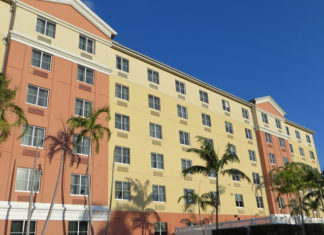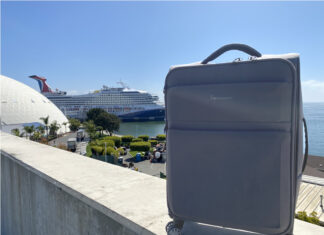At Cruzely, we spend much of our time focused on ocean cruises — those trips that criss-cross the Caribbean headed to Mexico, Cuba, Jamaica, and more on some of the largest ships in the world.
But over the past decade or so there has been a dramatic rise in interest of river cruises. Instead of sailing across the open water to warm-weather getaways, these trips take a different route through inland waterways to spots that are very different than the widely-visited Caribbean ports.
Truth is, if you are used to ocean cruising on mass-market lines, then river cruising is a completely different experience. And in fact, many people simply love the different way to sail and much prefer it to cruising on larger ships.
If you’re interested in knowing more about river cruises, here are several ways they will differ from ocean trips…

Smaller Ships on River Cruises
First things first, the ships on a river cruise are going to be smaller than their ocean-going sisters… much smaller.
Whereas the largest cruise ships can hold upwards of 6,000 passengers, river ships will typically hold between 100 and 200 guests. For instance, the Viking Torgil of the famous Viking River Cruises has only 53 passenger staterooms on the ship. Viking Longship Njord has 95 staterooms.
And while ocean passenger liners can measure more than 1,000 feet long and 15 decks, a river cruiser will come in significantly shorter and have usually just three to four decks.
River Cruises Have a Different Atmosphere
Umbrella drinks, Hawaiian shirts, and conga lines? Maybe on a trip to Cozumel, but river cruises have a different atmosphere and vibe. Things are more subdued, where you are more apt to spend your time on deck watching the scenery go by with a glass of wine than attending a belly-flop contest.
The typical passenger is a bit older than you’d find on a mass-market cruise, with not as many younger folks that you’d find on a weekend cruise from Miami.
There’s Less of an Impact on Ports
Take a regular cruise to a popular port like Nassau in the Bahamas, and not only are you in port, but it’s likely 3-4 other ships will be as well. It’s not unusual to hit a port with 10,000 to 20,000 other cruise passengers at the same time. The result is a cruise port that’s overloaded with passengers, who then all disappear when the ships go away.
Instead, since river cruises offer smaller vessels, the impact on ports is much smaller. You can actually get a feel for the port itself without the influx of tourists. If you’d much rather explore a port without a million other people around, river cruises are a better option than ocean cruises.
You’ll Visit Lesser-Known Ports
One of the appeals of river cruises is that they can go inland, so instead of being restricted to major ports along the coast where other large ships go, passengers get to see the “real” part of the country. European river cruises, for example, can take you from Amsterdam to Cologne to Vienna to Budapest — of which all except Amsterdam are inaccessible to large ocean-going cruise ships.
What does that mean for your trip? You’re going to see cities and towns that are genuine; not those who have been transformed to capture tourist dollars. You’ll have a more authentic experience compared to what you might find on an ocean cruise.
River Cruises Are More Expensive
One of the reasons that traditional ocean cruises are so popular is that they are highly affordable. If you want to go cheap, then you can book a week-long cruise with an interior cabin for just a few hundred dollars per person. Yes, fares can be much higher for higher levels of cabins, but you can have a high-end cruise for two people for just a few thousand dollars.
Expect to spend a bit more on a river cruise. The popular trips in Europe can easily cost between $2,000 to $4,000 per person for a trip. And remember that if you live in North America, then you’ll also have to include airfare to get to your ship.
Much More Is Included in Your Fare
Yes, you’ll spend more on a river cruise. The good news, however, is that you also usually have more included in your fare. While you might be charged for things like alcohol and Internet use, on river cruises you can often find these included. Things like transfers, bottled water, wi-fi, beer, wine, drinks, can be included. Another big plus? Some river trips include a free shore excursions in every port. That can save you hundreds — or even thousands of dollars — during your trip.
There is a Focus on Culture
If you go on a river cruise for getting sun, having a drink and maybe some partying, then you should adjust your expectations. To give you and idea, Viking River Cruises dubs itself “The Thinking Person’s Cruise.” There is a large focus on culture where you are likely to visit a famous museum instead of a famous beach. Even onboard there is a heavy focus on thoughtful travel, including emphasis on the library and cooking demonstrations instead of hairy-chest contests you might find on a traditional cruise.
You’re More Likely to Get to Know Other Passengers
On a ship with 4,000 passengers, you might recognize some faces but it’s like being in a new city. On the much smaller river ships you are on a ship with just a couple of hundred people at most. That means you’ll see the same faces each day. And given that you are sharing the same experience in a smaller space, you are likely going to engage with these folks on a daily basis — and maybe even make lifelong friends. After all, you share at least one common interest if you are both on a cruise!
There Are Fewer “Days at Sea”
Take a traditional cruise and you’re likely going to have several days at sea. On these days, you are in the middle of the ocean with only the things on the ship to keep you entertained. On a river cruise, you aren’t likely to have many of these. The trips typically stop each day at port, sometimes even with overnight stays. You spend much more time in ports compared to an ocean trip.
River Cruises Have Fewer Things to Do On the Ship
If you think of a cruise ship, you might think about evening shows, casinos, rock-climbing walls, a dozen different restaurants and more. Set those expectations aside for a river trip. As mentioned earlier, the ships are smaller and more focused on culture than having a wild time. There might be a pool and some spots on the top deck to get some sun, but in general there are fewer things for passengers to do on a river cruise ship. It’s meant to be more of a cultural experience where you take in the scenery and share the experience with other versus running from attraction to attraction on the ship.






